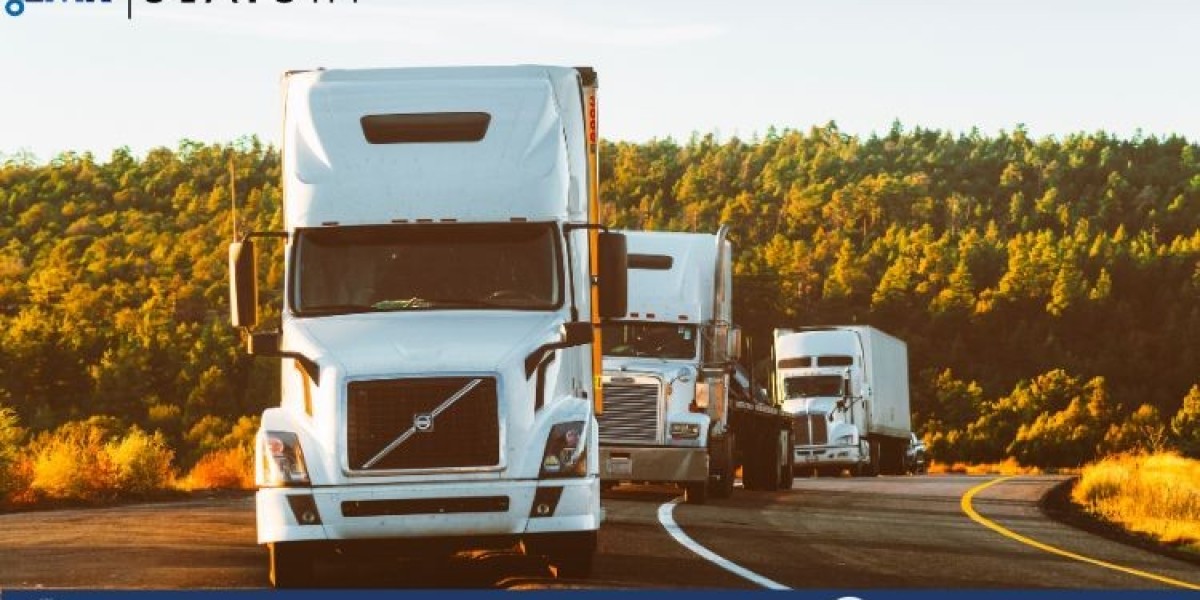The global truck platooning market size reached a value of about USD 99.46 million in 2023. The market is further expected to grow at a CAGR of 60.50% in the forecast period of 2024-2032 to reach a value of approximately USD 7029.20 million by 2032. Truck platooning technology, characterized by a convoy of trucks driving closely together with the help of advanced connectivity and automation systems, promises to revolutionize the freight transportation industry. In this article, we will delve into the potential advantages and challenges of truck platooning and its impact on the future of freight transportation.
I. Advantages of Truck Platooning
Truck platooning offers numerous benefits that have the potential to significantly enhance the efficiency, safety, and sustainability of freight transportation:
Improved Fuel Efficiency: One of the primary advantages of truck platooning is its ability to improve fuel efficiency. By driving in close formation, trucks reduce aerodynamic drag, leading to fuel savings for all vehicles involved. Studies have shown that truck platooning can achieve fuel savings of up to 10% for the lead truck and 5-8% for following trucks, resulting in substantial cost savings for trucking companies and reduced greenhouse gas emissions.
Reduced Emissions: The increased fuel efficiency achieved through truck platooning translates into lower emissions of greenhouse gases and air pollutants. With the transportation sector being a significant contributor to air pollution and climate change, the environmental benefits of truck platooning are substantial. By reducing emissions, truck platooning helps mitigate the environmental impact of freight transportation and contributes to efforts to combat climate change.
Enhanced Safety: Truck platooning systems utilize advanced sensors, cameras, and vehicle-to-vehicle communication technologies to maintain safe distances and prevent collisions. By coordinating the braking and acceleration of trucks within the platoon, these systems reduce the risk of accidents and improve overall road safety. Studies have shown that truck platooning can significantly reduce the number of rear-end collisions and other accidents, making roads safer for all users.
Increased Productivity and Efficiency: By enabling trucks to travel closely together in a convoy, truck platooning can improve traffic flow, reduce congestion, and increase the throughput of goods. This results in higher productivity and efficiency in freight transportation operations, allowing companies to deliver goods more quickly and cost-effectively. Truck platooning also reduces the need for additional infrastructure investments, such as widening highways or building new roads, to accommodate growing freight volumes.
Potential for Autonomous Driving Technology Integration: Truck platooning serves as a stepping stone towards the development and deployment of fully autonomous trucks. While current truck platooning systems require a human driver in each vehicle to take control if necessary, future iterations may eliminate the need for drivers altogether. Fully autonomous truck platoons have the potential to further enhance safety, efficiency, and productivity in freight transportation, revolutionizing the industry in the years to come.
II. Challenges of Truck Platooning
Despite its numerous advantages, truck platooning faces several challenges that need to be addressed for its widespread adoption and implementation:
Technological Limitations and Infrastructure Requirements: Truck platooning relies on advanced connectivity and automation systems, requiring robust infrastructure and reliable communication networks to support seamless operation. However, many regions lack the necessary infrastructure, such as dedicated lanes and roadside communication equipment, to enable truck platooning on a large scale. Addressing these technological limitations and infrastructure requirements is essential for the widespread adoption of truck platooning technology.
Regulatory and Legal Considerations: The deployment of truck platooning systems is subject to regulatory frameworks and legal requirements governing vehicle automation, safety standards, liability issues, and driver licensing. Clear guidelines and regulatory frameworks are needed to address legal uncertainties and ensure compliance with existing regulations. Harmonizing regulations across different jurisdictions is also necessary to facilitate interstate and international truck platooning operations.
Driver Acceptance and Training: The successful implementation of truck platooning depends on the acceptance and cooperation of truck drivers. Many drivers may be apprehensive about the introduction of automation technology and the potential impact on their jobs. Providing comprehensive training and education programs can help drivers understand the technology, its benefits, and their roles and responsibilities within the platoon. Engaging with drivers and addressing their concerns is crucial for gaining their support and participation in truck platooning initiatives.
Cybersecurity Concerns: The connectivity and communication systems used in truck platooning are vulnerable to cyber threats and hacking attacks. Cybersecurity breaches could compromise the safety and integrity of truck platooning systems, leading to potential accidents or disruptions in freight transportation operations. Robust cybersecurity measures and protocols are needed to protect against cyber threats and ensure the reliability and security of truck platooning technology.
Potential Impact on Employment in the Trucking Industry: The widespread adoption of truck platooning and autonomous driving technology could have implications for the workforce in the trucking industry. While automation has the potential to improve safety and efficiency, it may also lead to job displacement or changes in job roles and skill requirements. Addressing the potential impact on employment and supporting affected workers through retraining and transition programs is essential for ensuring a smooth transition to automated freight transportation systems.
III. Environmental Impacts and Sustainability
Truck platooning has the potential to contribute to environmental sustainability and support efforts to mitigate climate change:
Reduction in Greenhouse Gas Emissions: The improved fuel efficiency and reduced congestion achieved through truck platooning can lead to lower emissions of greenhouse gases such as carbon dioxide (CO2), nitrogen oxides (NOx), and particulate matter (PM). By reducing emissions, truck platooning helps mitigate the environmental impact of freight transportation and supports efforts to achieve climate change mitigation goals.
Contribution to Sustainability Goals and Initiatives: Truck platooning aligns with global sustainability goals and initiatives aimed at reducing carbon emissions, promoting energy efficiency, and transitioning towards cleaner and more sustainable transportation solutions. By supporting the adoption of truck platooning technology, policymakers and stakeholders can advance sustainability objectives and contribute to a more environmentally friendly transportation system.
Potential for Integration with Renewable Energy Sources: Truck platooning systems can be integrated with renewable energy sources such as electric and hydrogen fuel cell technology. By powering trucks with clean energy sources, truck platooning further reduces greenhouse gas emissions and dependence on fossil fuels, accelerating the transition towards a low-carbon transportation system. Investing in renewable energy infrastructure and incentivizing the adoption of clean energy technologies can enhance the sustainability benefits of truck platooning.
IV. Case Studies and Real-world Applications
Several real-world examples and case studies demonstrate the practical applications and benefits of truck platooning technology:
Case Study 1: Successful Implementations of Truck Platooning in Europe: European countries such as Sweden, the Netherlands, and Germany have been at the forefront of truck platooning research and development. Pilot projects and trials have demonstrated the feasibility and effectiveness of truck platooning in reducing fuel consumption, improving safety, and enhancing freight transportation efficiency. The European Union has provided funding and support for truck platooning initiatives as part of its efforts to promote sustainable transportation solutions.
Case Study 2: Pilot Projects and Trials in the United States: In the United States, several states have conducted pilot projects and trials to evaluate the feasibility and benefits of truck platooning. Companies such as Peloton Technology and TuSimple have partnered with truck manufacturers and logistics providers to test truck platooning systems on highways and interstates. These pilot projects have shown promising results in terms of fuel savings, emissions reduction, and safety improvement, paving the way for broader adoption of truck platooning technology in the U.S. freight transportation industry.
Case Study 3: Commercial Deployment and Adoption in Asia-Pacific Countries: Countries in the Asia-Pacific region, including Japan, China, and Singapore, are increasingly investing in truck platooning technology to address growing freight transportation demand and environmental concerns. Commercial deployments of truck platooning systems have been launched in these countries, with companies such as Toyota and Volvo leading the way in developing and deploying automated trucking solutions. These initiatives aim to improve transportation efficiency, reduce congestion, and enhance road safety in urban and industrial areas.
V. Future Outlook and Market Trends
The future of truck platooning holds significant potential for growth and innovation:
Growth Prospects for the Truck Platooning Market: The truck platooning market is expected to witness rapid expansion in the coming years, driven by technological advancements, regulatory support, and increasing demand for efficient and sustainable freight transportation solutions. Market research reports project significant growth in market size and revenue, indicating strong demand for truck platooning technology worldwide.
Technological Advancements and Innovations: Ongoing research and development efforts are focused on enhancing the capabilities and functionalities of truck platooning systems. Advances in connectivity, automation, vehicle-to-vehicle communication, and sensor technology are expected to further improve the safety, efficiency, and reliability of truck platooning operations. Companies are investing in research and innovation to develop next-generation truck platooning solutions that address current limitations and meet future transportation needs.
Collaboration and Partnerships within the Industry: Collaboration between technology providers, truck manufacturers, logistics companies, policymakers, and other stakeholders is crucial for driving innovation, addressing challenges, and accelerating the adoption of truck platooning on a global scale. Public-private partnerships, industry consortia, and research collaborations play a vital role in advancing truck platooning technology and promoting its widespread adoption across different regions and sectors.
Impact of Emerging Trends such as Electrification and Connectivity: Emerging trends such as the electrification of vehicles and the integration of connectivity and data analytics technologies are expected to complement truck platooning initiatives. Electric trucks powered by renewable energy sources offer an environmentally friendly alternative to traditional diesel trucks, further reducing emissions and dependence on fossil fuels. Connectivity technologies enable real-time communication and data exchange between vehicles, infrastructure, and logistics systems, enhancing coordination and efficiency in freight transportation operations.








